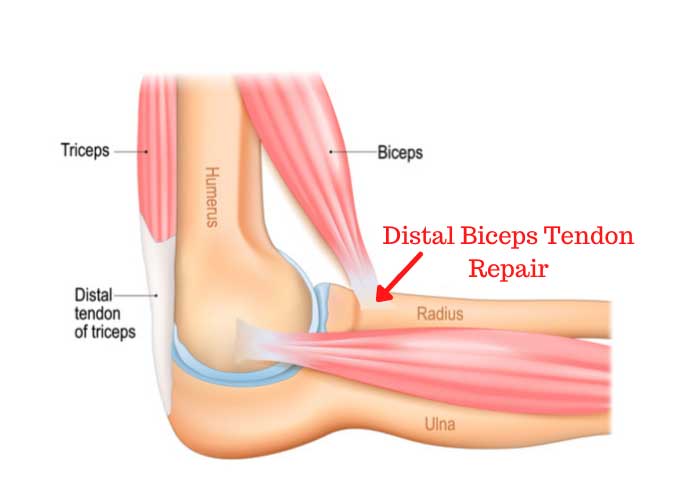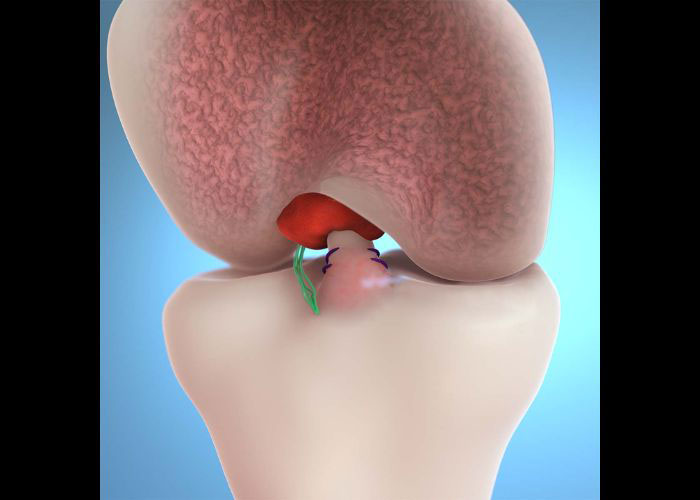What is a distal biceps tendon injury?
The biceps are two muscles that are responsible for outward rotation and flexion of the forearm at the elbow. These muscles originate at the top of the shoulder and travel along the anterior (front) portion of the upper arm to the radial tuberosity, a bony prominence on the radius (thumb side forearm bone), where they are anchored by the distal biceps tendon. A distal biceps tendon injury occurs when this tendon becomes partially or completely separated from its attachment site on the radial tuberosity. Although rare, a distal biceps tendon injury necessitates immediate surgical intervention to reattach the tendon to the correct anatomical site. The individuals with the highest likelihood of sustaining a distal biceps tendon injury are weightlifters and those who lift unusually heavy objects as part of their work duties.
What is the treatment for a distal biceps tendon injury?
Asymptomatic distal biceps tendon injuries or patients with mild partial tears of the distal biceps tendon may consider initial treatment with non-operative therapies. These can include rest, ice, elbow joint immobilization for a short duration, physical therapy, and non-steroidal anti-inflammatory medications (NSAIDs). Surgical correction is the best treatment for this type of injury in most cases, however, so immediate medical attention by an orthopedic doctor with extensive knowledge in treating distal biceps tendon injuries is strongly advised. The surgical repair of a distal biceps tendon injury involves fastening the damaged tendon back to its anatomical attachment site on the radial tuberosity. The goal of a distal biceps tendon repair is to restore function and strength to the biceps muscles. Dr. Ronak Mukesh Patel, orthopedic elbow doctor, treats patients in Sugar Land, Pearland, and the Houston, Texas area, who have experienced a distal biceps tendon injury and are in need of surgical repair.

How is a distal biceps tendon repair performed?
Dr. Patel typically performs a distal biceps tendon repair as an outpatient procedure using a minimally invasive open technique. A small incision is created surrounding the radial tuberosity to visualize the distal biceps tendon and surrounding elbow structures. Surgical instruments are utilized to excise and remove the damaged fragments from the tendon. The remaining healthy tendon tissue is then fastened back to the radial tuberosity with either special surgical anchors that are secured within the bone or by sutures inserted through a small cortical metal button that is then passed through a tunnel created in the radius bone.
Occasionally, patients may experience tendon retraction (chronic biceps tendon injury) if a significant amount of time passes between the distal biceps tendon injury and surgical intervention. This tendon shortening is often accompanied by scar tissue that makes for a difficult surgical repair. For these particular cases, Dr. Patel may implement a tendon graft from either the patient (autograft) or a donor (allograft) into the native biceps muscle which is then anchored to the radial tuberosity. Dr. Patel will utilize an open surgical approach in these circumstances to visualize the entire elbow while completing the necessary revisions.
What is the recovery period like after a distal biceps tendon repair?
The severity and complexity of the distal biceps tendon injury typically determine the recovery period following a distal biceps tendon repair. The specific surgical technique performed by Dr. Patel should not impact the recovery timeline as surgical methods are minimally invasive. The majority of patients can expect a full recovery with a return to their normal daily activities in approximately 3 to 5 months. Compliance with the post-operative care instructions provided by Dr. Patel can also greatly influence this recovery period. Patients in Sugar Land, Pearland, and the Houston, Texas area can anticipate:
- Immobilization: A splint is applied immediately after surgery to immobilize the elbow for a short duration of 1 week or less. The patient is then transitioned to an elbow brace to protect the tendon during the healing process while allowing early range of motion.
- Pain Management: A combination of rest, ice, and non-steroidal anti-inflammatory medications can alleviate any post-operative pain and inflammation. Dr. Patel can prescribe stronger pain medication, to be taken as directed, for any breakthrough pain.
- Physical Rehabilitation: Passive range of motion exercises begin within 1 week after surgery. Strengthening exercises typically begin 6 weeks after surgery with clearance from Dr. Patel. Active participation and completion of the individualized physical therapy program utilizing a specific protocol is the key to a successful recovery following a distal biceps tendon repair.
Distal Biceps Tendon Repair Surgeon

The distal biceps tendon attaches at the elbow and is responsible for strength and motion. A tear in this tendon usually occurs from weight lifting, or in activities that cause a strong, downward motion while the tendon is flexed (like golf). Not all biceps tendon injuries require surgery, however, a complete tear should be addressed immediately. Distal biceps tendon surgeon, Doctor Ronak Mukesh Patel, provides diagnosis as well as surgical and nonsurgical treatment options for patients in Houston, Sugar Land, and Pearland, TX who have injured their distal biceps tendon. Contact Dr. Patel’s team today!








